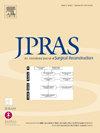软骨保留耳廓成形术 - 3 年内完成 288 只耳朵。
IF 2
3区 医学
Q2 SURGERY
Journal of Plastic Reconstructive and Aesthetic Surgery
Pub Date : 2024-09-17
DOI:10.1016/j.bjps.2024.09.031
引用次数: 0
摘要
背景:耳廓成形术的标准方法可能存在解剖变形的风险。之前的研究展示了一种新颖的软骨保留技术。本研究的目的是在更大的群体中证实该方法的安全性和有效性:这项回顾性研究纳入了2021年1月至2023年12月期间由一名外科医生采用单一技术进行耳廓成形术的患者。符合条件的患者年龄大于 5 岁,耳朵突出或收缩或杯状,与乳突形成 2 厘米的距离。手术技术包括新型关键点缝合。最少随访 6 个月。从患者病历中收集了有关人口统计学、风险因素、围手术期管理和并发症的数据:结果:共纳入了 288 例手术耳(147 例患者)。平均年龄为 17 岁,其中 91 人(61.9%)为女性。平均随访时间为 24.3 个月。术后并发症一般较轻,包括聚二氧酮(PDS)缝线外露(16 例,占 5.5%)、可控制的术后疼痛(8 例,占 2.7%)、肿胀自行消退(8 例,占 2.7%)、轻微出血(7 例,占 2.4%)和表皮并发症(4 例,占 1.3%)。有 4 只耳朵(1.3%)发生感染,并通过局部/口服抗生素得到了有效治疗。耳朵部分松动的病例无需干预即可治愈(4 例,1.3%)。只有 4 只耳朵(1.3%)出现了矫正功能丧失的情况,可根据需要选择重新手术。分析表明,术后并发症的年龄差异不明显,男性术后肿胀率高于女性的趋势不明显(10.7% vs 2.2%; P = 0.054):数据证实,该技术可提供安全、快速、并发症少、复发率低的软骨保留耳廓整形术。结论:数据证实,该技术可提供安全、快速的软骨切除耳廓整形术,并发症少,复发率低,可确保突出耳廓畸形患者获得持久、美观的效果:证据等级:三级。本文章由计算机程序翻译,如有差异,请以英文原文为准。
Cartilage-sparing otoplasty – 288 ears in 3 years
Background
Standard methods of otoplasty may risk anatomical distortion. Previous work showcased a novel, cartilage-sparing technique. This study aimed to confirm the safety and effectiveness of the method in a larger cohort.
Methods
This retrospective study included patients undergoing otoplasty by a single surgeon using a single technique between January 2021 and December 2023. Eligible patients were aged >5 years and had prominent or constricted or cup ears, forming a 2 cm distance from the mastoid. Surgical techniques included novel key-point sutures. Minimum follow-up was 6 months. Data on demographics, risk factors, perioperative management, and complications were collected from patient records.
Results
A total of 288 operated ears (147 patients) were included. The mean age was 17 years, and 91 (61.9%) were female. The mean duration of follow-up was 24.3 months. Postoperative complications were generally minor and included Polydioxanone (PDS) suture exposure (n = 16, 5.5%), manageable postoperative pain (n = 8, 2.7%), self-resolving swelling (n = 8, 2.7%), minor bleeding (n = 7, 2.4%), and superficial skin complications (n = 4, 1.3%). Infections occurred in 4 ears (1.3%) and were treated effectively with topical/oral antibiotics. Cases of partial release of the ear resolved without intervention (n = 4, 1.3%). Only 4 (1.3%) ears experienced loss of correction, with options for reoperation available as needed. Analysis showed no significant age differences in postoperative complications and a nonsignificant trend towards higher postoperative swelling in males than in females (10.7% vs 2.2%; P = 0.054).
Conclusions
The data confirms that this technique offers safe and rapid cartilage-sparing otoplasty with minimal complications and low recurrence rates. It ensures long-lasting and aesthetically pleasing results for prominent ear deformities.
Level of evidence
Level III
求助全文
通过发布文献求助,成功后即可免费获取论文全文。
去求助
来源期刊
CiteScore
3.10
自引率
11.10%
发文量
578
审稿时长
3.5 months
期刊介绍:
JPRAS An International Journal of Surgical Reconstruction is one of the world''s leading international journals, covering all the reconstructive and aesthetic aspects of plastic surgery.
The journal presents the latest surgical procedures with audit and outcome studies of new and established techniques in plastic surgery including: cleft lip and palate and other heads and neck surgery, hand surgery, lower limb trauma, burns, skin cancer, breast surgery and aesthetic surgery.

 求助内容:
求助内容: 应助结果提醒方式:
应助结果提醒方式:


